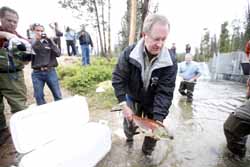forum
library
tutorial
contact

We're Bringing Salmon Back from Extinction
by Bill Booth and Lorri BodiIdaho Statesman, August 22, 2010
|
the film forum library tutorial contact |

|
We're Bringing Salmon Back from Extinctionby Bill Booth and Lorri BodiIdaho Statesman, August 22, 2010 |
 Something remarkable is happening in Central Idaho's Sawtooth Valley. Something the people of Idaho have not seen for generations.
Something remarkable is happening in Central Idaho's Sawtooth Valley. Something the people of Idaho have not seen for generations.
Snake River sockeye salmon are swimming 900 miles from the ocean to Idaho's mountains in numbers greater than any year since the 1950s. For the third year in a row, far more of these amazing red fish are returning to Redfish Lake than many people might have dared think possible only a few years ago.
In 2005, six sockeye returned. In 2006, three did. This year, perhaps 1,400 or more will make their way home. Nobody is declaring victory. But the consistently higher returns of the last few years are a powerful signal the sockeye and the region's efforts to help them are headed in the right direction.
This resurgence is a testament to the fish, of course. But it's also a testament to the state, tribes, policymakers and others who stuck with the sockeye when it would have been all too easy to give up on them. We should all be proud of what we're seeing today.
The fish withstood impacts from human development as well as historic land management practices and heavy commercial fishing. A precious few kept climbing fish ladders past eight dams on the Columbia and Snake rivers.
In 1990 the Shoshone-Bannock Tribes petitioned sockeye for listing under the Endangered Species Act. Idaho Fish and Game launched a conservation hatchery to preserve the genetics of the remaining fish, even when some doubted it would work. The Bonneville Power Administration funded the hatchery, plus stream restoration and fish passage systems to help salmon and steelhead travel through hydroelectric dams safely.
Only four years ago, though, when just three sockeye came home to Idaho, an independent science panel questioned whether the recovery effort could succeed. Too few fish remained, the panel said.
But the Northwest Power and Conservation Council stuck with the sockeye, backing the hatchery program. The council concluded that it sometimes takes high-risk investments to save a species. Idaho's elected leaders stood behind Idaho's fish. BPA continued and even expanded funding to raise and release more sockeye to rebuild their species.
That's just what they're doing: 650 returned to Redfish Lake in 2008 and 833 last year. This year there will be even more. Many will spawn in the wild.
Federal research in 2009 credited the upswing to Idaho's hatchery program as well as conditions in the ocean and in the Snake and Salmon rivers, above dams, as adult sockeye swam home. The spill of water past dams, helping young fish bypass turbines, has also evolved with science into a fundamental part of the federal strategy to protect salmon. The key for fish is not just more spill, but better survival. Collaboration has led to a widely supported strategy that tailors spill to the times and places it helps fish most.
Our commitment to sockeye is now greater than ever. The 2008 Columbia Basin Fish Accords brought together Idaho and two other states, the Shoshone-Bannock and four other tribes and federal agencies behind a concerted strategy to protect salmon and steelhead. Just last month, Idaho Fish and Game used BPA funds to purchase a site for a proposed sockeye hatchery that will boost releases of young fish to 1 million a year. All will be descendants of the original wild fish saved by Idaho Fish and Game in the 1990s.
We're no longer merely saving sockeye from extinction. We're actively bringing them back.
The Idaho Statesman asked an important question in 2005: "How long can our salmon continue to struggle while we argue over how to save them?" The answer is that we did not wait around to find out.
Related Pages:
Count the Fish by Government Accounting Office, GAO-02-612, Salmon and Steelhead Recovery Efforts
learn more on topics covered in the film
see the video
read the script
learn the songs
discussion forum
